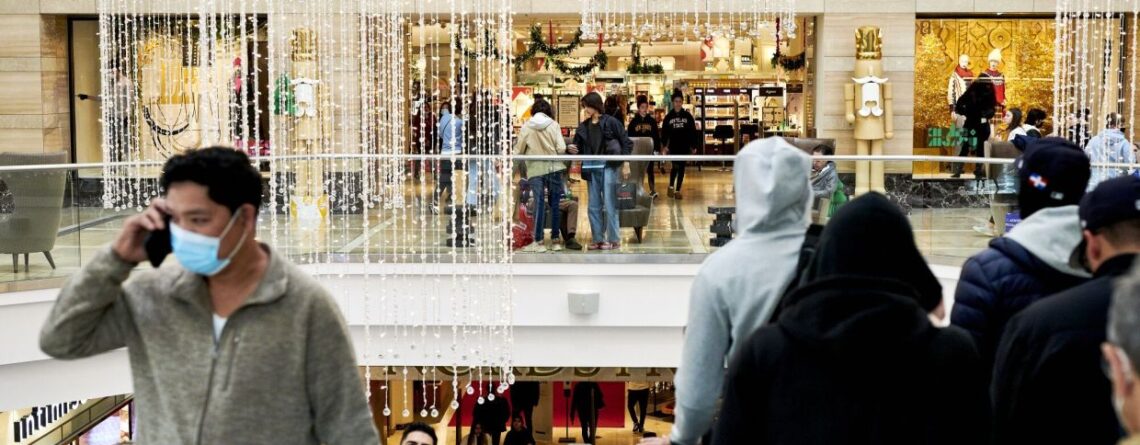US recession? Look at what rich Americans do on Black Friday
RICH Americans are curtailing their spending ahead of Black Friday, a worrisome sign for an economy that has so far depended on the US consumer to stave off a recession.
In the three months ahead of the all-important holiday shopping season, a group of retailers that cater to the upper middle class – including Apple, Coach and Nordstrom – saw its biggest sales drop in two years, according to an exclusive analysis of Bloomberg second measure data. The malaise also hit top-performing malls in wealthier areas, even as overall retail-sales figures march higher.
Despite record interest rates and soaring inflation, the upper middle class “had been driving a lot of the stronger-than-expected spending,” says Kayla Bruun, a senior economist for Morning Consult, a survey research firm.
Now, people with at least US$100,000 in household income are starting to become more frugal, she says.
On Tuesday, Best Buy Co and Lowe’s Cos cut their forecasts and warned that shoppers were pulling back on big-ticket items like appliances ahead of the holiday season.
Kohl’s Corp reported its seventh-straight drop in comparable sales, as a partnership with Sephora drew in customers but didn’t spur them to spend more money on other items at the department stores.
Even positive results at some retailers left investors wanting more as shares slumped at Abercrombie & Fitch Co and American Eagle Outfitters Inc.
Affluent shoppers often have an outsized impact on shifts in consumer spending because they have money to splurge when times are good but are quicker than the wealthy to pull back when feeling pressured. So a hit to the brands, retailers and shopping malls that cater to richer Americans foreshadows potential weakness ahead for the US economy.As a proxy for high-income spending, Bloomberg created an affluence index of 30 large retailers and brands across 10 categories – spanning clothing, jewelry and electronics – with average transaction values above their peer group.All the companies in the index surpassed an average of US$100 per purchase in October, save for makeup and skin-care sellers Sephora and L’Occitane.
Some retailers, including Apple (US$267) and West Elm (US$292), far exceeded that.
Most are popular holiday-shopping destinations, including Best Buy, Williams-Sonoma.
Deterioration in sales
The retailers and brands in the index experienced a deterioration in sales since January that recently deepened, according to Bloomberg second measure, which tracks anonymous US credit and debit-card transactions. Sales for the three-month period from August to October declined at 70% of the companies. The median change in sales reflected a 14% drop – the worst performance in two years. The few brands to defy the trend were the likes of Ugg, which Vogue earlier this year called the “hottest new shoe.”
Julie Robinson-Jasper, 54, whose Seattle household earns more than US$100,000 a year, is already planning to keep holiday spending tight. She’s capped gifts for her two children at US$600 –the same amount as the past three years, but with considerably less buying power after rapid inflation. The family is mostly eating at home to avoid higher prices at restaurants and turning to the resale market for clothing.
“We don’t want to be caught with our pants down if something were to happen again, like a layoff or an illness,” says Robinson-Jasper, who works for a plant nursery.
Foot traffic declining
Foot traffic at shopping malls that serve higher-income areas are also starting to decline for the first time since the pandemic, according to an analysis of Placer.ai mobility data for top shopping centers in 25 states.
On Oct, 21 of the 25 shopping destinations analysed – spanning Birmingham, Alabama, to Garden City, New York, and Bellevue, Washington – posted declines in foot traffic. Overall visits sank 3.3% for the latest three-month period, the worst performance since early 2021.
The softness extends to areas that have gained population post pandemic. On the outskirts of booming Houston, where household income is 20% higher than in Texas overall, the Baybrook Mall saw foot traffic drop by 660,000 visits this year, or about 6%, according to Placer.ai, which analyses mobile-phone location data.“Everybody is kind of in window-shopping behaviour right now,” says Bre Clinton, an assistant manager for the Body Shop at Baybrook Mall.
“They don’t have many bags in their hands.”
A slow start
Clinton, 25 years old, says holiday shopping is off to a slow start, with cheaper items like mini sizes of body scrubs selling better than pricier options. To attract shoppers, she says, the store is giving away more trial sizes of lotion.A spokeswoman for Brookfield Properties, owner of the Baybrook Mall, said that retail sales at the shopping centre were up in the 12 months through September and the firm is “thrilled” with its performance.
The slowdown at malls and retailers serving the upper middle class contrasts with the headline US retail-sales numbers, which have posted year-over-year growth since 2020, when the pandemic shut the economy down. — Bloomberg
Leslie Patton and Laura Bejder Jensen write for Bloomberg. The views expressed here are the writers’ own.













Leave a Reply